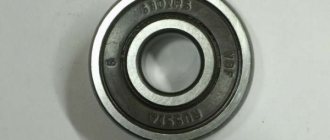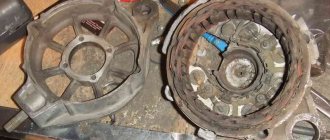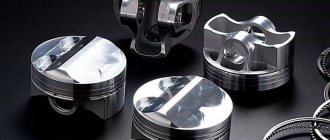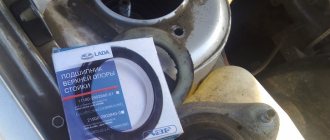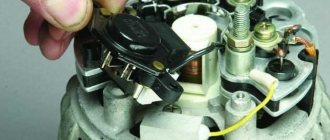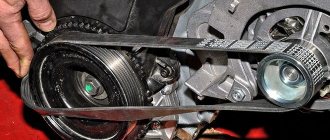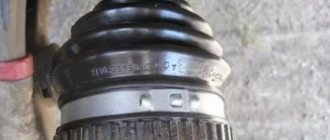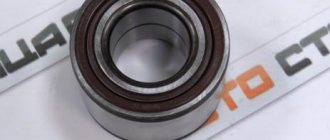The most common breakdowns
There are several popular problems with the generator, most of which can be solved by simply replacing components. For example, a vehicle may have a faulty ignition switch, which will require immediate replacement. A break may also occur in the power supply circuit of the instrument devices. You will notice that when you turn the ignition on, the light will stop turning on.
When the generator light does not give any signals both when the engine is running and when the ignition is turned on, check the functionality of the instrument panel. Most likely, the battery is discharged, and the voltage regulator relay is out of order.
Also, the cause of this malfunction is oxidation of the contacts of the commutator rings and brushes, or their excessive wear or breakdown of the diode bridge. In this case, it is recommended to install new elements to replace those that have become unusable.
Even if the control light comes on, but the battery is being recharged, it is recommended to replace the voltage regulator relay. It would be a good idea to check the contact rings of the excitation trim and the contacts between electrical appliances and the generator terminals - they may have broken.
Does the voltage drop sharply, problems arise with the power steering, does the generator not charge or is it overheating? In such cases, it will also need to be replaced.
Design and principle of operation of the generator
This device converts the mechanical energy received from the crankshaft into electricity. Thanks to the generator, power is supplied to the electrical appliances of the car. It powers the ignition, recharges the battery and other systems. When the driver starts the engine, the largest amount of electricity is consumed by the starter. At this moment, power to electrical consumers is supplied only from the battery. Naturally, the battery may drain quickly. To prevent this from happening, it must be powered by a generator.
The generator consists of an aluminum housing, inside of which there is a rotor on bearings and a coil. There is a stationary stator between the back and front covers. A belt connected to the crankshaft causes the rotor to rotate. To rectify the current in terms of voltage and strength, a diode rectifier is used.
Generator device
The transmitting link is brushes - sliding contacts. They carry control current from the voltage stabilizer. Due to the stabilizer, the generator creates a voltage of about 14 Volts, regardless of the engine speed. It is important that the regulator remains in good working order, otherwise optimal voltage parameters will not be maintained. In this case, the auto electrician may fail.
The temperature of the operating generator is reduced by fans. The device is attached to the brackets using four bolts. It can be seen if you open the hood. The mounting points are located on the covers.
Appearance of the generator for Priora
It is important to promptly identify problems with the power supply. The first symptoms are the flashing of the headlights and the appearance of a warning light on the dashboard. If the generator breaks down or fails completely, the battery quickly runs out of power. In this case, it is impossible to even start the engine. The car cannot move.
Selection of components
The original generator, installed on a car with a 16-valve engine at the factory, is marked with article number 5102.377. Its cost, as a rule, fluctuates around six to seven thousand.
Carefully check the generator itself and its packaging before purchasing so as not to encounter a counterfeit
It is important that the part is free from unevenness, chips and paint drips, as well as foreign markings.
To avoid overpayments, you can purchase a similar original spare part. The following devices are suitable for installation on Lada Priora:
- VAZ (power 120/115a);
- KZATE (115a);
- BATE (90a);
- BOSCH (120a).
The price of analogues can be either higher or lower than that of the original. As a rule, it is in the region of 3500-6000 rubles. We choose a generator device with a large power reserve so that it lasts longer.
Keep in mind that installing less powerful generators is unacceptable, especially if you connect several different devices to the vehicle’s on-board network (when connecting a large number of electronics, it is generally recommended to increase the current). Before purchasing, we carefully check for damage to the case and the integrity of the unit.
Reasons for failure
There are many reasons for bearing failure, but there are several main reasons, which are discussed below.
Wear
On the left are old bearings, on the right are new bearings.
Wear is a typical cause of bearing failure, since the number of revolutions of the generator rotor is huge over the Nth period of time. Consequently, the lubricant in bearings under the influence of high temperatures loses its properties and the bearing ceases to receive the required slip coefficient, which causes heating and increased clearances in the ball part of the bearing.
Belt tension
Excessive tension on the alternator belt greatly affects the life of its bearings. It is necessary to tension the belt correctly, observing all norms. The generator belt should bend under the influence of 10 kg. by 5-7 mm.
Instructions for removing the unit on a car with air conditioning
Before replacing the generator bearing on a Priora, you should stock up on a set of tools, which will include:
- universal set of keys. Heads for 7, 10, 12, 13, 17, 24 are required;
- set of hexagons;
- universal puller for ball bearings;
- minus and Phillips screwdriver;
- To diagnose serviceability, you will need a multitester;
Removing a generator on a Priora Lux, with air conditioning and power steering
If you need to replace the generator bearing on a car that is not equipped with air conditioning, then it is convenient to remove it by dismantling the right headlight of the Lada Priora. The unit is located on the left side of the engine when viewed from the radiator. The best access to the mechanism is to remove the headlight and bumper mount on the passenger side.
Note: Attention! All work related to the repair of “genes” is done with the negative terminal of the battery removed
- Disconnect the terminal.
- Remove the protective cover.
The headlight is attached to 2 bolts - one under the housing, the second from below the headlight. It can be accessed by removing the bumper mount on the right side.
- Unscrew the top headlight mount.
- Lower the right side of the bumper to gain access to the lower headlight mount.
- We unscrew the lower bolt and the headlight is removed from its mounts. Carefully disconnect the power cables and set the headlight aside.
- This is what you will see from the headlight side: access to the fasteners, pulley, and belt tension adjustment.
This is only part of the job. It is necessary to raise or lower the tubes and hoses of the hydraulic systems and dismantle everything that interferes with the removal of the mechanism. First, let's dismantle the absorber.
- Remove the absorber hoses.
- We remove the absorber. It is secured with 2 bolts: one in the picture, the second below.
The path is almost clear. The air conditioner pipes are in the way. They are attached to the bracket.
- We unscrew the bracket and the air conditioner tubes can be freely raised or lowered.
All. The path is clear. All that remains is to unscrew the mounting bolts. The top bolt is accessible.
- Unscrew the top bolt securing the unit.
You will have to tinker with the bottom bolt. There are 2 options:
Stick your hand in with a 17mm socket wrench, feel for the bolt and put the wrench on hold. 13mm bolt nut
Remember that there is a sleeve on the bolt under the head; do not lose it when you pull the bolt out. Carefully remove the electrical unit. Remember that there are wires going to it
Disconnect them as soon as possible.
Note: An easier way is if it is possible to park the car in a pit. Remove the protection from below, you will have access to the lower mounting bolt. Unscrew it without any problems. Note: After the dismantling stage, you should check the serviceability of the electric generator itself by checking the operating voltage, find out the bearing number for the Priora generator, and only then begin disassembling it.
Removing a generator on a Priora without air conditioning and power steering
Above we discussed the method of dismantling the generator through a removed headlight. Let's try to get to the electric generator from below. It is best to do this in a garage with a pit, but it can also be done outside.
Note: Attention! Be careful when working under a vehicle. Place the car raised by jacks on the supports and securely fix it
- Raise the hood and remove the negative terminal of the battery;
- We remove the protection. Unscrew the fastening bolts. They are located around the perimeter and are easy to access. First unscrew the 2 bolts at the back.
- We hold the protection from below with our hand, unscrew the last front bolt, and remove it. Access to the lower mount is free.
- Using a 13mm wrench, unscrew the nut of the lower “gene” mounting bolt. Do not unscrew the nut all the way, because you will have to tap it to remove the bolt. Don't forget the bolt bushing.
- Unscrew the belt tensioner bolt.
- Then remove the wires under the rubber cap and the plug (indicated by arrows)
- We disconnect the top fastening using two 13mm keys.
- We hold it by the body, remove the top bolt and remove the “genu” through the bottom.
Note: If you are working without an assistant, first remove the upper mounting bolt, and then the lower one.
Installation at the mounting location, after repair or replacement of the unit, is performed in the reverse order.
Pullers for standard parts
It is enough to simply knock the front bearing out of the cover with a hammer, even if there is a flange, so in 99% of cases only a puller for the rear bearings of the generator of two types is used:
- with two legs;
- with three legs;
Moreover, the device can be made independently; the most popular are two designs:
- the lower part of the split bushing is put on the outer race of the bearing, a bolt passes through the upper part, the halves of the bushing are pulled together by a tubular casing, a cover made of thick-walled metal is put on the bolt under the nut;
- in a square pipe, cuts are made from below, into which, after being placed on the outer race of the bearing, steel plates are inserted; a nut is welded to the top of the pipe, into which a bolt of sufficient length is screwed.
With homemade devices, replacing a generator bearing is both faster and cheaper. However, they will take some time to produce.
Imported or domestic
Imported analogues of bearings have a slightly different designation, namely:
Most 80-amp generators have bearings of similar sizes, at least this applies to domestic ones. If the generator has already been replaced before you, then you may be faced with the fact that a generator from a different manufacturer is installed and the bearings are of different sizes. Depending on the generator manufacturer, bearings of other sizes are sometimes found, for example, in the fairly common Bosch 14V 53-98A 0124 415 038 generator, bearings 6003-2RS (rear) are installed, the dimensions of which are 17 × 35 × 10 and 6303-2RS (front) , respectively, 15×35×14. The same bearings can be found in other imported generators. However, there are options where the rear bearing is designated as 6000-2RS, and the front bearing – 6203-2RS.
In order to accurately determine the dimensions of the bearing, it will have to be removed. If the markings on the bearing are not visible, then it is best to turn to professionals (you should not trust a caliper).
If you have decided on the size of the bearing, then to the repeated question “What bearings are on the VAZ-2110?” The answer suggests itself - original!
The quality of bearings varies from manufacturer to manufacturer; some prefer to install bearings from domestic manufacturers on their generators, while others prefer imported ones. When repairing a generator, everyone decides this issue for themselves, but after listening to numerous tips, some car enthusiasts are inclined to choose imported ones. If you focus on price-quality ratio, many experts recommend DAS LAGER Germany. But there are other suppliers of quality bearings: the French company SNR; FAG is one of the leading companies in Germany; NSK is another major bearing manufacturer from Japan; NTN – Japan; Kouo - part of the Toyota concern of Japan; Kraft or BOSCH.
We also supply bearings from Chinese manufacturers, but the attitude of motorists towards generators and bearings from the Middle Kingdom is far from flattering. A bearing is considered original if it is approved by the vehicle manufacturer for sale on the market. It usually corresponds to what is (or was previously) supplied to the assembly line. The car manufacturer guarantees that these bearings will not let you down.
If you are considering various options, then all the bearings with the corresponding markings at first glance look the same, but after opening the package, you need to pay attention to the marking, which, in addition to the designation of the bearing itself, consisting of digital and letter designations, must contain an indication of the manufacturer and necessarily the country of origin. If this is not the case, then it is quite possible that it is a fake.
In this case, the money lost will not be that big (most often up to 100 rubles per bearing). But you will lose significant time and nerves.
Recommendations
Comments 24
Everything was resolved - one bearing was burnt, dry and jammed, the second had a little oil but was loose. I changed the bearings to FBJ. I also changed the slip rings, they were worn out. I wanted to install a three-level regulator, but it didn’t work, which means no luck. The original tablet gives 13.4-13.6 with the low beam on, of course with the air conditioning it will also work, but the tablet is also proven and working
tensioner, take off the belt
According to the code, manufacturer BATE 21120-3701010-05 for 90A (Belarus) front bearing 302
Here are good bearings for the gene
There’s also this garbage: I changed the tensioner periodically, the problem did not go away, for 165,000 I’m already on the third pump, the second gene and the second set of timing belts, but the problem never went away, I have a feeling that until something in the internal combustion engine warms up - there is a rustling sound, it is quite possible that this is the rustling of the engine belt or timing belt. Although, of course, if you take their bearings at the service center, and after starting everything is the same, then the job is not done, if you bring your own, they have the right to say that you brought them from China, but there are no excuses here.
Take off the belt and you will understand the reason, most likely the bearing. The pump may also rustle (on your engine, oh no)
and the bearings are in the genes: the rear is always 202, and the front is 302 (old model, 15 shaft) or 303 (new model, 17 shaft)
and in front of this where is the pulley?
Yes, the front is where the pulley is, and the back is where the brushes go.
and in front of this where is the pulley?
there is a method for determining without removing the pulley and measuring, but I’ll make a reservation, it’s mine personally and if I’m absolutely sure that no one has repaired the generator before: if the RR is of the old model, without wiring, then the gene is of the old model and the front bearing is 302. If the RR is of a new model, with two additional wires, the front bearing is 303.
Oh, I'll watch it tomorrow!
there is a method for determining without removing the pulley and measuring, but I’ll make a reservation, it’s mine personally and if I’m absolutely sure that no one has repaired the generator before: if the RR is of the old model, without wiring, then the gene is of the old model and the front bearing is 302. If the RR is of a new model, with two additional wires, the front bearing is 303.
Your method is incorrect. Nothing depends on the type of launch vehicle. And it depends on the manufacturer. The rear covers of the generator are the same, the seat for the launch vehicle and the diode bridge are the same. The same generators may have one relay or another.
Method 100%. Manufacturer: factory. Rubbish like China, Ukraine, etc. In principle, I don’t consider it.
Your method is incorrect. Nothing depends on the type of launch vehicle. And it depends on the manufacturer. The rear covers of the generator are the same, the seat for the launch vehicle and the diode bridge are the same. The same generators may have one relay or another.
On generators n/o there is also a pp n/o and a reinforced front cover, respectively, bearing 303. The method is 100%, if no one has climbed into the gene, I already wrote about this.
In this case, I have only seen the “new model” generators you indicated in one Samara and one Chevy Niva. (But I often install these DM and RN myself. Instead of the usual ones)
And the rest of the cars, including those bought in a store and untouched by generator repairs, I came across with generators of both standard sizes, pulley mounting nuts, rotor shaft diameter, etc. But with a conventional LV and a nine-diode bridge. Somehow your 100% theory doesn’t work.
By the way... I repair on average from two to ten generators per week. Sometimes 3-4 a day... I’m silent about China, that’s understandable. It's complete horror.
I don’t know what kind of generators you have there, where they get them from and who installs them. I have 126 cars in my fleet, all from the factory. I don’t think it’s the leftists (those who come from the street for repairs, the so-called “shabashki”), you can ask AvtoVAZ for these genes, they’ll say the same thing as me. Well, I personally became convinced of this while repairing a car. AvtoVAZ’s letter about genes is 100% confirmed. Another thing is that the genes n/o and s/o are not linked by year - yes (n/o can be on a car produced in 2004, but on a car produced in 2007, for example, it comes from the factory with a c/o, etc. .) P.S: here only about factory genes, not about Bulgaria, China, basement kzate - of which more than half are in the stores in our city. the engraving is somehow crooked) p.s.: we have genes n/o and s/o about 50/50 on the car.
and the bearings are in the genes: the rear is always 202, and the front is 302 (old model, 15 shaft) or 303 (new model, 17 shaft)
If the pulley mounting nut is S24, then bearing 6303. If the nut is smaller, S21, then 6302.
Don’t forget about the tension roller, just stop by the service center and listen with a stethoscope, give them a hundred rubles and you’ll know exactly what to change
the sound comes from the gap between the cover farthest from the pulley - there are technological gaps there
Generator bearings Lada Priora: diagnostics and signs of malfunction, causes
The following circumstances may indicate that it is necessary to replace the generator bearing:
- extraneous noises during startup, possible humming or whistling;
- interruptions in the operation of the vehicle’s electrical equipment;
- constant insufficient battery charge;
- uneven shaft rotation, distinct runout.
You can diagnose the malfunction as follows:
- remove the belt;
- start the engine and listen carefully. If nothing buzzes, then the sound came from the ball bearing;
- move the pulley. If there is play, it must be replaced.
These videos will help you understand the diagnostic procedure:
The Priora generator bearing is noisy:
Whistling in the electric generator and overheating:
How the electric generator hums:
How to check generator bearings:
Where is the generator located at Priora - the device of the VAZ 2170 unit
The unit itself for a car with air conditioning (or power steering) looks like this:
- Drive pulley for additional elements;
- Tension roller;
- Mounting the right side of the engine;
- Electric generator pulley;
- Air conditioning blower pulley.
If a VAZ Priora without air conditioning (or without power steering), the configuration changes slightly and looks like this.
During disassembly, you will have to disconnect the belt and remove the engine protection. The belt tensioner will need to be replaced. There is also the option of dismantling the part through the car headlight. Below we will describe in detail how to change bearings in a generator, including the process of dismantling, disassembling the electric generator itself, and installing new elements.
Air conditioning systems
One of the consumers is a heating device. It is part of the climate control system. A control controller works with this system. The work is automatic. The driver only sets certain parameters.
On cars, the electrical circuit of a VAZ Priora may contain air conditioning systems. After pressing the button, the relay is activated, the compressor is turned on, power is supplied to the electromagnetic clutch, and the pump is turned on. The air conditioning turbocharger begins to rotate, creating pressure, and begins to regulate refrigerant through the system.
Generator replacement process
Most often, the unit fails precisely after connecting various electronic devices to the onboard part of the car. The more energy consumers there are, the higher the generator voltage should be.
This is why we recommend that you consider the number of electronic devices you use when purchasing a new node. The best option is generators with 115-120 amperes.
Let's get started with the work. To dismantle the generator you need a 13 key:
- Disconnect the battery. Remove the mechanism drive belt according to the operating instructions.
- Disconnect the connector from the D+ connector. Then move away the rubber boot to gain access to the fastening of the contact pin and the wiring block.
- Now unscrew the fixing nut and remove it. Remove the screw and get rid of the remaining fasteners. Don't forget about the adjusting screw.
- When all fasteners are removed, dismantle the tension bar.
- Remove the mechanism itself.
Now you can replace individual elements or purchase a new unit. After completing the repair work, all that remains is to install the generator in place; the process itself is almost identical (performed in reverse order).
Please note that if you are the owner of a Lada Priora with air conditioning, the process of removing the generator will be slightly different:
- Remove the protection and disconnect the positive terminal from the generator.
- Lower the belt tensioner roller and unscrew the air conditioner fasteners.
- Move the air conditioner away to make room for further removal of the generator.
- After unscrewing all the fasteners, carefully remove the device.
Don't forget to adjust the strap tension to avoid malfunctions of the mechanism. Then tighten the tension film fixing nut, maintaining a torque of 20 Nm. Be sure to rely on the diagrams during installation to avoid mistakes that will lead to system failure.
You may need additional replacement of bearings and diode bridge. If you have doubts and are not sure that you can carry out the procedure for replacing components yourself, it is better to contact a salon.
Lada Priora Hatchback › Logbook › Replacing generator and belt bearings
Hello everyone, it all started with the appearance of a hum when starting it cold, when it warmed up the hum subsided. But in any case, you shouldn’t delay repairing the genes, since a worn bearing can jam. Depending on the year of manufacture, the generator can be old or new. The only difference is in the diameter of the shaft, the old one is 15mm, the new one is 17mm. For a shaft with a diameter of 15mm you need bearing number 302. For a shaft with a diameter of 17mm you need bearing number 303. The rear bearing for all generators is the same with number 202
I waited for warm weather, started to eliminate the hum, opened the hood, took off the belt and started it, the hum disappeared. It was not easy to remove the gene, since the car is with Conder. It’s better not to climb without such a set))
I took it off from my guy for the duration of the repair, I removed it for the first time at the Prior, so I took it off for about three hours, first we unscrew the air conditioner compressor and move it to the side, and we unscrew the gene along with its fastening to the block, so the fastening will not allow the gene to be pulled out from the bottom, with in reverse order. And I put it in place in just 40 minutes.
Here he took off the plastic cover
We clamp the pulley in a vice through the rubber gaskets (so as not to damage it) and unscrew the pulley nut (24 head), then mark the relative positions of the generator covers, unscrew the four coupling screws, they are tightened well, and are made of fairly soft metal, so we unscrew them either with an impact screwdriver , or an ordinary Phillips, but with a large tip, the voltage regulator (brushes) is still in good condition
took it apart
pressed out the bearings this way
the bearings were dry pressed in like this (the old bearing was used as a mandrel
collected it
I bought a strap and it fit perfectly.
I also installed a new tension pulley, now it’s quiet and calm under the hood)
Tips and tricks
Generators and brushes come in four types, depending on the year of manufacture of the Lada Priora. Typically, removing the air conditioner is required in cars with a 127 engine. In this case, the air conditioner pipes are located below the radiator. These tubes completely cover the gap between the radiator and the block. Therefore, dismantling without removing the compressor will be quite problematic. First you have to disconnect the air conditioner pump from the brackets.
It is also not easy to remove the bolt that is screwed to the generator from below. The bolt can be unscrewed if it is on the side opposite the motor. Otherwise, the bolt will be located next to the engine mount, and you will have to cut it off with a circular saw. This operation will take an extra 10 minutes. It is better to position the new fastener with the head in the desired direction so that there are no more problems when unscrewing.
If the compressor is already unscrewed, it does not need to be attached. It will cling to surrounding elements. When screwing the air conditioner into its old place, you must first install all the bolts, and only then screw them in. It is also advisable to start the engine after assembly and check how the generator operates. Only then can the bottom be screwed on.
Priora. Generator repair.
99% that this is due to the bearings.
We remove the generator from the car. To do this, simply unscrew the lower ear bolt and the upper ear adjusting bolt. We take it to the workbench.
The initial inspection did not show any severely damaged bearings, but a small amount of play was still present. In advance, the owner of the Priora purchased a set of two generator bearings.
Remove the pulley and rear plastic casing. To remove the pulley, we use the original generator belt for the noose. This makes it easier to unscrew and tighten the pulley mounting nut.
We visually inspect (for now) all the elements for burnout, fraying and soot. I didn't like the wiring from the capacitor. The insulation on it had melted. Or frayed. During assembly, I insulated it with electrical tape.
The brush assembly with voltage regulator is new. There are no questions for him. But the copper current collectors are not so hot. The continuity test, voltage regulator and diode bridge did not reveal any anomalies. Everything is in working order.
Now it's up to the bearings. By the way, the plastic support sleeve of the rear rotor bearing, which is located in the rear cover, must also be replaced.
We completely disassemble the generator. We take out the winding and half the covers.
It is better to remove the bearings themselves from the rotor using normal pullers.
True, I had an incident that caused me a lot of trouble. Not because of my crooked hands, but because of my crooked eyes. The domestic manufacturer made the rotor shaft from such raw metal that during the process of pressing out the front bearing, I did not see that under the action of the puller rod, the rotor shaft simply flared out... like plasticine.
And there is a threaded part on which the pulley is seated and the nut is tightened. Thread M14, thread pitch 1. I cursed at myself for a long time...
Anyway. The second problem is that from a set of new bearings, the rear one fit, but the front one turned out to be larger than the old one.
I called the owner and by the evening I had the required bearing. I went to a specialized store and luckily they had the die I needed in stock.
We press on new bearings.
All that remains is to repair the flared threaded shaft. Grinded around the circumference. And cut a new thread.
After which the pulley stood up as it was. Tightened the nut.
All that remains is to put the generator in place. Check the voltage on the battery, start it and check the voltage on the battery with the generator running. In our case, there is charging, everything works quietly and smoothly.
Dear Prior owners, the tablet on your generator can be changed without removing the generator from the car! This task takes me 15 minutes, and you have 300 rubles of money)))
So, send away such servicemen who stupidly cheat you out of your money! All the best
Maintenance frequency of car generator bearings
When servicing the unit, you need to know which bearings are on the generator, and which race of each of them is pressed into place. To extend the time between overhauls, bearings are lubricated at the time of installation at the factory or when replaced by the user. It is believed that this amount is sufficient for the entire life of the rolling elements.
The frequency of bearing replacement is determined by ear:
- if the generator is noisy, it means the clip has worn out;
- Before jamming, the generator bearing hums for quite a long time, so the owner usually has enough time not to let this happen.
Attention: It is usually difficult to determine by ear which of the two bearings has become unusable, so the rolling elements are replaced as a set - front and rear.
Design features of the generator are:
- one bearing is called the front bearing, since it is pressed into the corresponding (front) generator cover by the outer race;
- the second one is put on the shaft with tension on the reverse side, called the rear one, and is located near the commutator group;
- Before changing standard rolling consumables, you need to prepare a special tool;
- To get to the rolling parts, you will first have to remove the generator and then completely disassemble it.
For example, the front bearing can be knocked out, then a new rolling element can be installed in the mounting hole without a puller. It is important that the external dimensions match. It will not be possible to pull the rear bearing off the shaft in this way; a puller will be required. But you can put on a new standard product by tapping a hammer on a sleeve of a suitable size or an old bearing.
Diagnostics
If noises and hums appear in the operation of the engine, it is necessary to check and find the culprit of the noise. Most often it is the generator, but in order to exclude other culprits it is necessary to diagnose it.
It is not difficult to independently check the condition of the bearings; this only requires compliance with the points described below.
- Remove the generator belt from the crankshaft and generator pulleys
- We start the engine and listen
- If the noises, whistles, vibrations have disappeared and the internal combustion engine is working properly and smoothly, then the culprit is definitely the generator bearings.
- You can also grab the generator pulley and shake it up and down; there should be no play. Turn the rotor manually, there should be no whistles or squeaks, the rotor should rotate smoothly and softly.
How to tension the alternator belt
When checking whether the belt is tensioned on a Priora car, keep in mind that marks are applied to the camshaft pulleys. Rotate the crankshaft until the marks on the camshaft pulleys coincide with the cutouts on the reverse side of the drive.
With normal timing tension, the protrusion of the inner sleeve of the tensioner pulley should coincide with the opening of the outer race. If the belt is in good condition and the marks do not match 1/2 of the reach width, the tension should be adjusted.
- Loosen the bolt holding the tension roller.
- Make sure the cutout of the roller aligns exactly with the protrusion on the back of the roller bushing.
- Using wrench 15, tighten the tensioner pulley bolt.
- Simply put, to tension the belt, the generator roller needs to be turned in the opposite direction clockwise.
Modernization of the VAZ generator voltage regulator
- HUCO-130512
- Febi-17202
- Bosch-1197311028
- Hella-5DR 004 242-061
- Beru-0 190 005 004
- Standard voltage regulator (160r.)
- Voltage regulator from a foreign car for 14.5V.
- The photo shows a dismantled tablet with a foreign car's pH and a body with brushes.
- Because it is a little larger, it is not that easy to install. This is what a combined foreign-made 14.5V tablet looks like with our PH housing.
- And a standard pH and a 14.5V tablet assembled and ready for use.
- On a warm car, the voltage at the terminals is 14.4V
- With an average network load, the voltage was 14.2-14.3V
- When all devices were turned on, the generator voltage dropped to 14-14.1V and remained the same when the internal combustion engine warmed up to 90Co.
xn--2111-43da1a8c.xn--p1ai
Replacement
To replace it, you will need to remove the generator from the car and some plumbing tools. It would also be a good idea to have a generator bearing puller. Having all the necessary tools, you can handle the job with basic mechanical knowledge.
Puller
The puller greatly facilitates bearing replacement work, saving time, effort and nerves. This device is a faithful assistant not only when working with a generator, but also with other car parts.
It consists of claws and a thrust bolt. There are a large number of different pullers, they are: two-jaw and three-jaw. In our case, when working with a VAZ 2110 generator, it is best to use a two-jaw one; it is the most compact and convenient to dismantle the bearing.
Its cost varies from 200 to 1000 rubles, depending on the quality of the part.
Necessary tool
The tools you will need to complete the work are presented below:
- Ratchet;
- 13mm, 10mm key;
- 21mm head;
- 8 mm hexagon;
- Gas key;
- Powerful screwdriver “+”;
- Hammer;
- Puller;
- Punch;
- WD-40 (lubricant)
- Rags;
- Marker;
Stages of work
1. Disconnect the negative terminal from the battery. We unscrew the wires on the generator with a 10mm wrench and remove the generator excitation chip.
2. Remove the generator from the car. To do this, unscrew the generator belt tension bolt and remove the belt, unscrew the generator from the mounts and remove it from the car. Be careful not to lose the rubber bushing and washers when removing the lower mounting bolt.
3. Let's start disassembling. Remove the plastic cover of the diode bridge by bending the three latches. Unscrew the two screws securing the brushes to the body and disconnect the connector from the brushes. We mark the alignment of the covers with a marker so that in the future we can assemble everything correctly.
4. Using a screwdriver, unscrew the screws of the ends of the generator winding from the diode bridge and bend them. Unscrew the screw securing the capacitor and separate the diode bridge from the generator.
5. Unscrew the generator pulley with a 21 mm socket, holding it with a gas wrench and holding the rotor shaft with an 8 mm hexagon. We take out the generator pulley and thrust washer.
6. Unscrew the 4 bolts of the cover and remove it along with the stator winding.
7. Remove the back cover by pressing the manifold with your fingers and pull the cover towards you, remove the plastic bearing bushing.
8. Remove the bearings using a puller.
We assemble the generator in the reverse order.
Bearing sizes and manufacturers
Before replacing a bearing with a new standard product, you need to buy it. The marking of these standard consumables is complex; the numbers in it are deciphered using special tables. Moreover, bearing designations according to GOST 3189 do not coincide with the markings of foreign manufacturers, so the user needs to know the following nuances:
- the marking consists of three parts (main, left, right), and blocks inside them;
- in the left and main parts the blocks are located from right to left, and in the right block on the contrary, from left to right;
- in cars, the front bearing of the generator most often has the designation of the main part 302 or 303, and the rear bearing 202 or 203;
- usually radial ball modifications with code 0 (0302 or 0202) or angular contact balls with code 6 (6303 and 6203) are used;
- therefore, for the specified parameters, you can decipher the dimensions using the table below;
- For foreign-made bearings, similar markings are used.
The suffix (right side of the marking) of imported bearings contains additional information. For example, letters and numbers can represent:
- 2RS and RS – double-sided and single-sided rubber seals, respectively;
- N and NR – groove on the outer ring without a latch and with a latch, respectively;
- J – steel holder;
- Z – sheet protection on one side without seals.
The main problem for a car enthusiast when doing self-repair is the variety of bearing sizes inside the generator:
- it is difficult to guess the markings before disassembling, when the car is still running;
- after dismantling and disassembling the generator, the dimensions and markings are known to the owner, but he has to go to the store in a different car;
- in some stores, sellers practice a convenient system - the car owner takes 4 bearings 202, 203, 302 and 303, and returns two of them back.
These modifications have dimensions:
| Marking | External diameter (mm) | Inner diameter (mm) | Clip thickness |
(mm)
In view of the variety of brands and brands of cars, different power and design of generators, it is easier to study the manual before replacing bearings. In it, the marking of these standard parts and adequate replacement options are mandatory.
The most expensive bearings are considered to be from the manufacturer FAG - 450 rubles (6303 modification) and SNR - 400 rubles (6203 ZZ). Bearings from Koyo are half cheaper - 200 rubles for 6303С3, NTN - 180 rubles for 6203ZZ and Nachi - 150 rubles for 6203ZZ. A set of standard products for the KZATE generator on the VAZ 2114 (16 V) from the Chinese manufacturer C&U costs 1,100 rubles. By default, this generator is equipped with Chinese consumables SKF 6202 and SKF 6303 (both with the suffix 2RS) at the factory.
In the old VAZ 2110, the generator was equipped with bearings 302 and 202 2RS; the new ones use a generator with a different shaft; standard products 303 and 203 are required, respectively.
What bearings are on the Priora generator (VAZ 2170): size, price, article number
We have already figured out how to replace failed parts. Now it remains to understand which bearing is better to buy. There are different generators on Priors - 115A or 90A. The second is for a less powerful car without air conditioning and power steering. Ball bearings have a number (marking). The front element is 6303, the rear element is 6202.
There are a lot of both original and non-original spare parts on the market:
- Front ball bearing 6303: FAG 6303 2ZR (Germany), SKF 6303-2Z (Sweden), KOYO 6303 ZZ, CM (Japan), NTN 6303 ZZ (Japan).
- Rear ball bearing 6202: FAG 6202-С-2HRS, SKF 6202-2-RSH, KOYO 2RS, NTN; 6202LLU.
In addition to the bearings listed above, below is a table that will help you navigate the offers on the market and select the best quality part:
Selecting a generator bearing - price and manufacturers
| No. | Brand | Catalog number | Price 2022, rub. | ||
| Front | Rear | Front | Rear | ||
| 1 | ASAM Romania | 30904 | 30903 | 200 | 270 |
| 2 | Bosch Germany | 1120905533 | F00M990410 | 420 | 450 |
| 3 | NTN France | 6202-LLU | 6303-LLU | 280 | 330 |
| 4 | KOYO Japan | 140084 | 140093 | 400 | 500 |
Priora generator bearing dimensions
| Characteristic | Unit | Values according to GOST (TU) | |
| 6-180202 | 6-180303 | ||
| Inner diameter | mm | 15 | 17 |
| External diameter | mm | 35 | 47 |
| Height | mm | 11 | 14 |
| Static load capacity | N | 3550 | 6650 |
| Dynamic load capacity | N | 7800 | 13500 |
| Speed | rpm | 24000 | 19000 |
| Radial clearance | mm | 0,008-0,022 | |
| Steel type | — | SHH-15 | |
| Hardness of rings and balls | H.R.C. | 61-65 | |
| Lubricant type | — | C17, Litol | |
| Ring roughness | Ra | 0,32 | |
| Torque | H*M | — | |
| Number of rolling elements | PC. | 8 | 6 |
| Ball diameter | mm. | 5,953 | 9,525 |
| Weight | G. | 0,045 | 0,115 |
Size and catalog numbers
These parameters of the ball bearing are necessary for purchase, since without these numbers it is very difficult to buy the right part suitable for your car.
The dimensions of the bearings varied depending on the year of manufacture of the car, so the selection of a bearing can be carried out based on the year of manufacture. auto.
Cars manufactured before 2001 with carburetor engines they have bearings of type 6302 front and 6202 rear.
Cars produced after 2001 with injection engines, have bearings type 6303 front and 6203 rear.
Catalog numbers (articles) and external dimensions
Disassembly and assembly of the Lada Priora generator (VAZ-2170)
We disassemble generator 5102.3771 to check and replace the voltage regulator, rectifier unit, rotor, stator and bearings.
Checking the generator is shown in the “Fault Diagnosis” section.
The voltage regulator can be replaced on the car without dismantling the generator. For clarity, we show the replacement of the voltage regulator on a removed generator.
Use the 8mm socket to unscrew the nut...
...and remove the terminal from the “D+” terminal of the generator.
Using the “8” socket, unscrew the three nuts securing the casing.
Remove the generator casing.
Using a slotted screwdriver, unscrew the screw securing the voltage regulator output.
Using the “8” socket, unscrew the two nuts securing the voltage regulator.
Remove the voltage regulator.
We remove the gasket. To disassemble the generator...
...remove three washers from the casing mounting studs.
We use a marker to mark the relative positions of the generator covers.
Using a 7-point socket, unscrew the four bolts holding the covers together.
Remove the back cover with the stator assembly. If the stator does not come out of the front cover, pry it off with a screwdriver from different sides relative to the front cover.
We put a high “24” head on the pulley fastening nut and through its hole insert a “8” hexagon into the hole of the rotor shaft. We unscrew the pulley fastening nut, holding the tool head with a pipe wrench or in a vice.
Remove the spring washer.
...and a spacer washer.
We push the rotor shaft out of the front cover...
...and remove the cover. To replace the front bearing...
... use a slotted screwdriver to unscrew the four screws securing the bearing pressure plate.
Remove the pressure plate.
Use your hands to push the bearing out of its seat...
...and remove it. If it is not possible to push out the bearing, we knock it out using a mandrel or tool head of a suitable diameter.
To replace the rear bearing...
...using a two-jaw puller we press the bearing from the rotor shaft. When performing this operation, the puller screw should be pressed exactly into the center of the shaft so as not to damage the plastic insulator of the rotor slip rings. To install the puller grips, two flats are made on the plastic rotor bushing.
If it is necessary to remove the rectifier unit or stator...
...unsolder the six terminals of the stator winding from the terminals of the rectifier block... ...and unscrewing the three fastening nuts with an “8” wrench, remove the rectifier block and the stator.
We assemble the generator in reverse order.
To install the rear bearing, we rest the front end of the rotor shaft on a wooden block...
...and press the bearing onto the rear end of the shaft using a mandrel or a piece of pipe of suitable diameter, applying force only to the inner ring of the bearing. If the front bearing cannot be inserted into the generator cover...
...press the bearing into the cover using a suitable tool head, applying force to the outer ring of the bearing.
